 While working on a research problem in preparation for a consultation, I wanted to determine how common the surname Kucera was in the Czech Republic. A name that seems fairly unusual here in the United States is often as common as Smith back in the old country. I found a web site, Czech Surnames, that gave a great deal of information about the origins of different Czech surnames, but also had a listing of the top 20 most popular surnames in the country for the years 1937, 1964, and 1996. I discovered that Kucera, which means “curly,” was and is the ninth most common surname in the country. For the research problem in the consultation this was not necessarily good news, but it substantiated the above premise. Continue reading Czech surnames
While working on a research problem in preparation for a consultation, I wanted to determine how common the surname Kucera was in the Czech Republic. A name that seems fairly unusual here in the United States is often as common as Smith back in the old country. I found a web site, Czech Surnames, that gave a great deal of information about the origins of different Czech surnames, but also had a listing of the top 20 most popular surnames in the country for the years 1937, 1964, and 1996. I discovered that Kucera, which means “curly,” was and is the ninth most common surname in the country. For the research problem in the consultation this was not necessarily good news, but it substantiated the above premise. Continue reading Czech surnames
Category Archives: Genealogical Writing
Connecting cousins
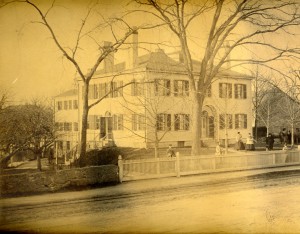 I noted in a previous blog post that my husband Paul and I are live-in caretakers at the William Clapp House in Dorchester, Massachusetts. This house was built in 1806 and serves as the headquarters of the Dorchester Historical Society. Paul and I assist the Society with special events, and we give tours of the house and grounds. The Clap name can be found in Dorchester records dating back to the 1630s – the surname is often spelled with one “p” for earlier generations of this family. Continue reading Connecting cousins
I noted in a previous blog post that my husband Paul and I are live-in caretakers at the William Clapp House in Dorchester, Massachusetts. This house was built in 1806 and serves as the headquarters of the Dorchester Historical Society. Paul and I assist the Society with special events, and we give tours of the house and grounds. The Clap name can be found in Dorchester records dating back to the 1630s – the surname is often spelled with one “p” for earlier generations of this family. Continue reading Connecting cousins
Changing town names
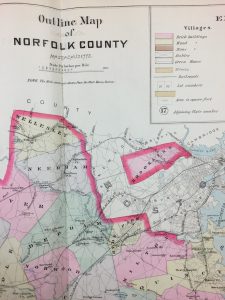
In documenting the dates on Mabelle Clifton (Lippitt) (Bourne) Bevins in my last post, her step-mother’s data reminded me of other issues that come our way in family history with new towns being created, or annexed, and the shifting borders of counties and states.
Mabelle’s step-mother, Lillian Hannaford Blazo, was born at Hyde Park, Massachusetts on 5 December 1869, daughter of William Augustus and Mary Elizabeth (Farnum) Blazo.[1] She married at Boston 7 March 1901, Robert Lincoln Lippitt.[2] This marriage listed her birthplace as Dorchester. Lillian died at Providence, Rhode Island 7 February 1937 and her death record listed her birthplace as Milton.[3] Why was there confusion on these two records?
Hyde Park was incorporated as a new town in 1868, just one year before Lillian’s birth, from lands in Dorchester, Milton, and Dedham. From that alone, it’s difficult to say if Lillian was born in the part of Hyde Park that had been Dorchester or Milton, without looking at land records or town directories to see where Lillian’s parents lived, assuming a home birth. Continue reading Changing town names
Deck the halls
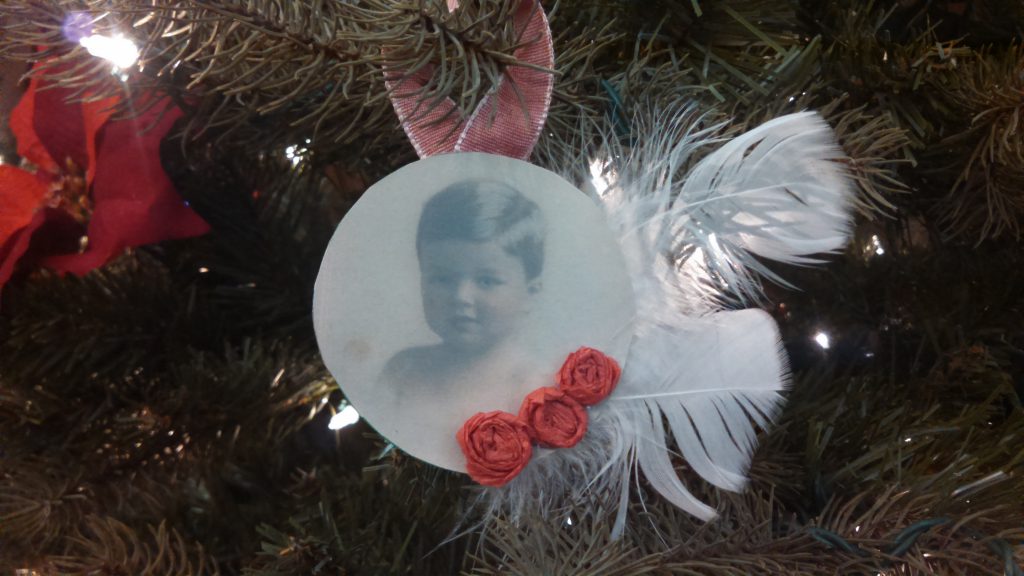 For some, the holidays are a time of heightened crafting – making wreaths, designing centerpieces, stringing popcorn garlands, knitting warm to-be-gifted hats and scarves, and building elaborate gingerbread wonderlands. For everyone, the holidays are a time to be with and celebrate family – present and past.
For some, the holidays are a time of heightened crafting – making wreaths, designing centerpieces, stringing popcorn garlands, knitting warm to-be-gifted hats and scarves, and building elaborate gingerbread wonderlands. For everyone, the holidays are a time to be with and celebrate family – present and past.
Since 2013, staff at NEHGS have combined spirited crafting and a passion for genealogy by creating special ornaments using (facsimiles of) family photographs. The ornaments adorn the tree at the Society and are taken home just before Christmas. Even among unrelated crafters, we can’t help but share the “who,” “what,” and “when” of our photos with each other. Some staff have even chosen to represent lines of descent within a single ornament (see below) – a family tree in 3D! Continue reading Deck the halls
A lesson in history
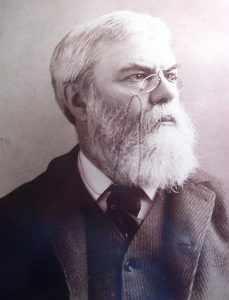
One might be surprised to learn that the profession of “historian” in America is a fairly recent creation. The American Historical Association (AHA), founded in 1884, was established partly in reaction to growing numbers of individuals who were pursuing the serious study of history.[1] America’s earliest historians were focused largely on recording the events and sequence of history: that is, political events, wars, and other nation-building activities. Only recently have America’s historians begun to ask what life was like for ordinary men, women, and minority groups – questions of significant relevance and interest to family historians and genealogists.[2] Continue reading A lesson in history
Former ancestors
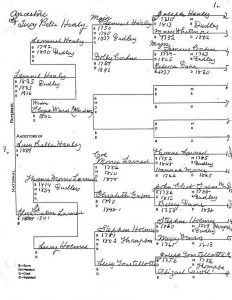
My recent post about twins in the family – correcting my ancestor Sarah (Johnson) Eaton’s ancestry – reminded me of various corrections to my family papers over the years. As I had indicated there, when I started my genealogical research, I was given an enormous head start on my native Connecticut ancestry. Two friends of my great-grandparents had prepared family charts tracing nearly all of my grandfather’s ancestors back to the immigrants in the 1600s. While this was a terrific help, over the years I have found sometimes that this material wasn’t always right. Many times the ancestors on the charts were listed in published genealogies, but my attempts to confirm the line have led me to revisit these ancestors, sometimes turning them into “former ancestors.” Continue reading Former ancestors
More twins in the family
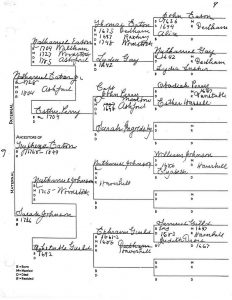 Earlier this year I wrote about my ancestor Tryphena Kendall and her twin sister Tryphosa. Tryphena and Tryphosa Kendall were the granddaughters of Sarah Johnson, who married Nathaniel Eaton at Ashford, Connecticut, on 13 November 1755. As I looked at the documentation I had on this family, something wasn’t quite right.
Earlier this year I wrote about my ancestor Tryphena Kendall and her twin sister Tryphosa. Tryphena and Tryphosa Kendall were the granddaughters of Sarah Johnson, who married Nathaniel Eaton at Ashford, Connecticut, on 13 November 1755. As I looked at the documentation I had on this family, something wasn’t quite right.
The family charts that I had on this part of my family were prepared by friends of my great-grandparents nearly 100 hundred years ago, and while I have verified much of this information over the years and corrected some data, I had never verified anything beyond Sarah (Johnson) Eaton. Continue reading More twins in the family
The Depression of 1641
 Sixteen forty-one was the first year after the end of the Great Migration. Between 1620 and 1640, an estimated 80,000 people left England because of the religious and political chaos there. About 20,000 each went to one of four places: New England, Ireland, the West Indies, and the Netherlands.
Sixteen forty-one was the first year after the end of the Great Migration. Between 1620 and 1640, an estimated 80,000 people left England because of the religious and political chaos there. About 20,000 each went to one of four places: New England, Ireland, the West Indies, and the Netherlands.
The political situation in Old England came to a critical point in 1640 when King Charles I, who had disbanded the Puritan-led Parliament in 1629, now needed the body to authorize money for his continuing religion-based wars in Scotland, Ireland, and on the Continent. Continue reading The Depression of 1641
Boston Transcript column now online
 The genealogy column in the Boston Evening Transcript newspaper has been one of the more heavily used resources at the NEHGS Library for the past century or more. The paper was published, under a few different titles, from 1830 to 1941. From 1906 through 1941, it featured a genealogy column in which readers would submit and respond to queries. During most of its run, the column appeared twice a week. According to an editors’ note which appeared in many issues, the newspaper was almost overwhelmed with submissions and had a backlog waiting to be published. The editors also claimed that they had “correspondents in every corner of the country.” By the time it ceased publication, the column had covered an estimated two million names. Continue reading Boston Transcript column now online
The genealogy column in the Boston Evening Transcript newspaper has been one of the more heavily used resources at the NEHGS Library for the past century or more. The paper was published, under a few different titles, from 1830 to 1941. From 1906 through 1941, it featured a genealogy column in which readers would submit and respond to queries. During most of its run, the column appeared twice a week. According to an editors’ note which appeared in many issues, the newspaper was almost overwhelmed with submissions and had a backlog waiting to be published. The editors also claimed that they had “correspondents in every corner of the country.” By the time it ceased publication, the column had covered an estimated two million names. Continue reading Boston Transcript column now online
Option D
 In reviewing past literature on a family in England, I was reminded of the many potential scenarios afforded by kinship assignments in documents. In this case, these documents concern the ancestry of Henry Bright (1602–1686) of Watertown, Massachusetts, a native of Bury St. Edmunds, Suffolk. Henry was the son of Henry and Mary (Woodgate) Bright, and the grandson of Thomas and Margaret Bright.[1] Thomas Bright wrote his will on 20 August 1587, mentioning, among other kinships, his wife Margaret and father-in-law Mr. Jervis, of Whepstead.[2] Continue reading Option D
In reviewing past literature on a family in England, I was reminded of the many potential scenarios afforded by kinship assignments in documents. In this case, these documents concern the ancestry of Henry Bright (1602–1686) of Watertown, Massachusetts, a native of Bury St. Edmunds, Suffolk. Henry was the son of Henry and Mary (Woodgate) Bright, and the grandson of Thomas and Margaret Bright.[1] Thomas Bright wrote his will on 20 August 1587, mentioning, among other kinships, his wife Margaret and father-in-law Mr. Jervis, of Whepstead.[2] Continue reading Option D